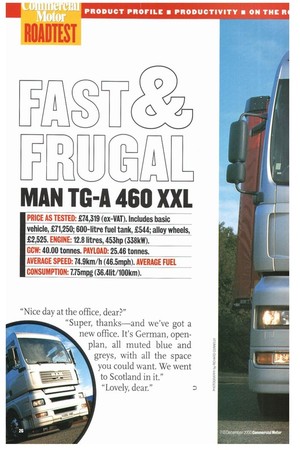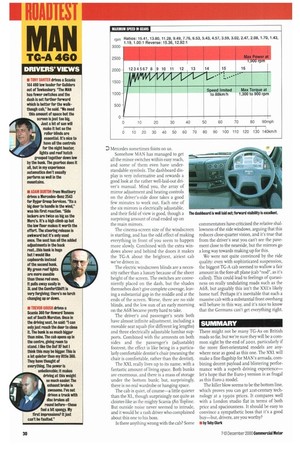MAN TG-11460 XXL
Page 28

Page 30

Page 31

Page 32

If you've noticed an error in this article please click here to report it so we can fix it.
IPRICE AS TESTED: £74,319 (ex-VAT). Includes basic vehicle, £71,250; 600-litre fuel tank, £544; alloy wheels, £2,525. ENGINE: 12.8 litres, 453hp (338kW). GCW: 40.00 tonnes. PAYLOAD: 25.46 tonnes. AVERAGE SPEED: 74.9km/h (46.5mph). AVERAGE FUEL CONSUMPTION: 7.75mpg (36.41it/100km).
AN decided to take a topdown approach when it launched the all-new TGA range, introducing the largest XL and XXL cabs before the narrower models. We have already tested the TG-A 410 fitted with the XL cab (CM 19-25 October) and gave it top marks— we reckoned it was a truck which would please a driver and his boss in equal measure.
This time we are shifting the emphasis in the driver's favour, with the unashamed luxury and imposing presence of the top-of-therange XXL cab. A worthy successor to the renowned Roadhaus series, the XXL is a high-roof monster with a nearly flat floor and plenty of room for two...or for one rather spoilt resident.
PRODUCT PROFILE
MAN is offering the TG-A only in 02 form at the moment, but given the recent swing back to 4o-tonners this may not be a problem. In any case, a three-axle version should be available soon after the 44-tonne legislation comes in. Less excusable is the fact that we had to test a Euro-2 version: with the moves of other manufacturers to make Euro-3 models available, you might think MAN would go out of its way to show off the most advanced version of its flagship truck.
Scania has already proved that a Euro-3 truck can deliver good fuel economy with its mighty 164.580 (CM 5-11 October 2000). In any case, if you order a TG-A now it will come with the EGR-equipped Euro-3 motor.
The 460 engine (actually rated at 453hp) is the latest evolution of MA N's electronically controlled r2.8-litre straight-six, which manages without common-rail injection or unitpump technology. It delivers 2,tooNm (1,5491bft) of torque at low revs (from 900rpm), but if you're frightened of all that you can opt for the 4iohp variant, with a maximum torque of 1,85oNm (1,3641bft) but a similar-looking torque curve.
The engine is mated to ZF's old faithful, the i6-speed Ecosplit synchromesh box (here with a direct-drive top). But there's a twist it is now equipped with ComfortShift, which uses a thumb-operated button on the gear lever to disengage the clutch. Earlier versions worked only in high range. but now you can use the system on any shift, even across the range. It's a useful system, as we'll see.
Our test truck also came equipped with the standard 3.08:r single-reduction drive axle, but if you like there's the option of a super-tall 2.7m ratio.
The chassis itself is conventional (albeit with deformable under-run protection at the front), but the running gear is bang up to date. The ventilated disc brakes Front and rear are actuated via an electronic braking system (EBS), which incorporates ABS and ASR (anti-skid) via the electronic CAN bus connections that link every part of the truck.
The big cab is undeniably impressive, and it uses electronically controlled four-point air suspension to keep things comfortable. But despite the truck's breathtaking size, MAN claims it has kept its weight under control. We shall see...
PRODUCTIVITY
We were very impressed by the 4 iohp TG-A, finding it gave creditable fuel economy and excellent driving manners at a realistic price. Thankfully, the 460 XXL seems to have been made to the same recipe, delivering a very worthy 7.75mpg round our Scottish route at 40 tonnes, at an average speed barely slower than the 580 Scania's. It performed well on every part of the test, even returning an impressive 5.48mpg on the hard-as-nails A68 section. A few years ago this would have been a benchmark figure for a Euro-r, 38-tanner. On each of the three days it was about 3% down on the results given by the 4rohp TG-A, but it was a fair bit quicker overall.
If the fuel consumption is acceptable and the average speed excellent, the payload is quite a bonus. Even with the monstrous Goolitre fuel tank fitted (and full to the brim), the tractive unit scaled at 7,540k8. The standard 410-litre tank would save almost zookg to give a practical trailer/payload allowance of more than 32.5 tonnes.
The price is right, too: just over £74,000 in this spec, including a comprehensive threeyear repair-and-maintenance package. That's £4,000 less than Iveco's EuroStar 430 and more than L50,000 cheaper than flagship models from Volvo and Scania.
1, cio-1,9oorpm) there's a brighter section to show the optimum revs. This is usually lit up between 1,300 and i,5oorpm, but if you're using the exhaust brake it jumps to 2,0002,20Orpal,
The engine itself does not seem to have the ruler-flat torque plateau of previous MAN units—and it's all the better for it. Drop down below the 1,300-1,500rpm green point and it digs in, refusing to drop below 1,200rpm except under extreme provocation.
Top gear seems perfectly judged for general UK work: 55mph equates to about 1,420rpm (right in the middle of the green) and the engine stays there happily. Indeed, on the rolling A74 between Gretna and Glasgow it remained in top, on cruise control, all the way; the one exception was a downshift to get the revs up for the exhaust brake on a downhill stretch. The only fly in the ointment was a nasty rattle from the steering column shroud at Lioorpm or so.
If you were to opt for the 2.71 back axle, the speed limiter would come in at a very lazy 1,250rpm in top. This might be just the job for undemanding motorway work, but it would make hilly motorways a little less relaxing.
Top gear is pretty flexible, and can just about hold the truck at 40 mph on not-toochallenging A-roads, trickling along at just over 1, 000rpm, but 8L (just below the illuminated green on the rev counter) is a lot more flexible—and avoids that steeringcolumn rattle. Even if you do need a downchange, it's no bother: a half-gear adjustment needs only a flick of the splitter switch and a short press on the ComfortShift button.
Better still, a gearchange doesn't reset the cruise control, so you're back in business straight away. Look, no feet! But ComfortShift gearchanges are not fast: on the critical hills of the A68 we opted for old-fashioned clutch control. ComfortShift is arguably just a halfway house before the fully automatic TipMatic system becomes standard, but it works well in its own right, using wellproven technology.
Using the exhaust brake is just as simple. It's a quick press of the button on the righthand stalk (the one that isn't the cruise-control stalk) and a change down of, say, a gear and a half to get to the useful range at just over 2,0 oorpm. The brake is not as good as a retarder (which is the real purpose for that separate stalk), but it gives useful holding power with surprisingly low noise levels.
The EBS brakes are as sharp as you would expect and hope, and showed no sign of fade on the A68. They also have the advantage that—even without a matching EBS-equipped trailer—the tractor-trailer brake compensa
tion should be correct at all times.
Other drivers have commented that TG-A's steering is excellent—night, pre and with plenty of feedback" was our vet on the XL—but the XXL cab seemed to its responses. The steering just felt a I: remote, particularly on long motor stretches. Still, there was enough control the A68, and the low-profile tyres .plenty of warning if we were about to I grip. This probably explains the 4E scorching time up the Carter Bar hill clii where a couple of long bends usually his powerful truck's performance.
CAB COMFORT
MAN's build quality has always been go but it's excelled itself this time: the plastics solid, creak-free and pleasant to the touch, the fabrics are plush and reasonably colour Not the eye-watering monstrosities t Mercedes sometimes foists on us.
Somehow MAN has managed to get all the minor switches within easy reach, and some of them even have understandable symbols. The dashboard display is very informative and rewards a good look at the rather well-laid-out driver's manual. Mind you, the array of mirror adjustment and heating controls on the driver's-side door takes a good few minutes to work out. Each one of the six mirrors is electrically adjustable, and their field of view is good, though a surprising amount of crud ended up on the main mirrors.
The cinema-screen size of the windscreen is startling, and has the odd effect of making everything in front of you seem to happen more slowly. Combined with the extra windows above and behind the doors it makes the TG-A about the brightest, airiest cab we've driven in.
The electric windscreen blinds are a necessity rather than a luxury because of the sheer height of the screen. The switches are conveniently placed on the dash, but the shades themselves don't give complete coverage, leaving a substantial gap in the middle and at the ends of the screen. Worse, there are no side blinds, and the low sun of an early morning on the A68 became pretty hard to take.
The driver's and passenger's seats both have almost infinite adjustment, including a movable seat squab (for different leg lengths) and three electrically adjustable lumbar supports. Combined with the armrests on both sides and the passenger's (adjustable) footrest, the effect is like being in a particularly comfortable dentist's chair (meaning the chair is comfortable, rather than the dentist).
The XXL really lives up to its name, with a fantastic amount of living space. Both bunks are enormous, and there is a mass of storage under the bottom bunk; but, surprisingly, there is no real wardrobe or hanging space.
The cab is quiet, of course—a little quieter than the XL, though surprisingly not quite as doister-like as the mighty Scania 580 Topline. But outside noise never seemed to intrude, and it would be a rash driver who complained about this one to his boss.
Is there anything wrong with the cab? Some commentators have criticised the relative shallowness of the side windows, arguing that this reduces close-quarter vision, and it's true that from the driver's seat you can't see the pavement dose to the nearside, but the mirrors go a long way towards making up for this.
We were not quite convinced by the ride quality: even with sophisticated suspension, the biggest TG-A cab seemed to wallow a fair amount in the fore-aft plane (cab "nod", as it's called). This could lead to feelings of queasiness on really undulating roads such as the A68, but arguably this isn't the XXL's likely home turf Perhaps it's inevitable that such a massive cab with a substantial front overhang will behave in this way, and it's nice to know that the Germans can't get everything right.
SUMMARY
There might not be many TG-As on British roads so far, but we're sure they will be a common sight by the end of 2001, particularly if the more fleet-orientated models are anywhere near as good as this one. The XXL will make a fine flagship for MAN's armada, combining decent payload and blistering performance with a superb driving experience— let's hope that the Euro-3 version is as frugal as this Euro-2 model.
The killer blow seems to be the bottom line, which proves you can get 21st-century technology at a 1990s prices. It compares well with a London studio flat in terms of both price and spaciousness. It should be easy to convince a sympathetic boss that it's a good buy—but, drivers, are you worthy?
• hy Toby Clark








































































































